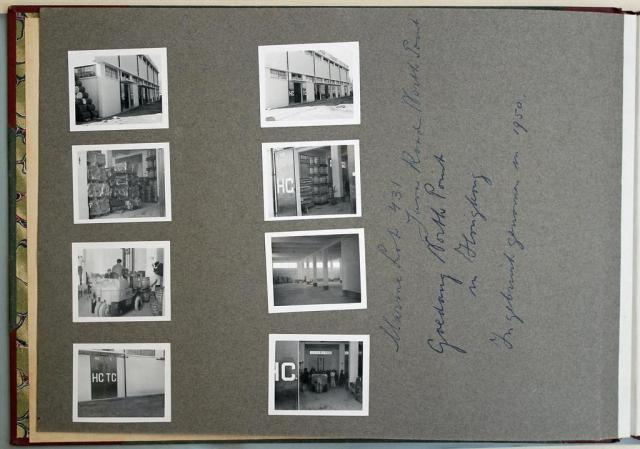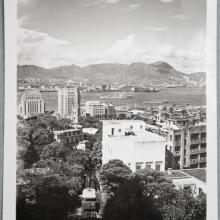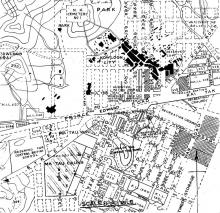Charles Gesner van der Voort had started his career in Rotterdam, at Holland-China Trading Company (HCHC). In 1938, he went to Shanghai for the firm. The Japanese interned him, and most other Dutch nationals, from 1943-45. In camp, he met his wife Nancy and they married after the war. After a leave in The Netherlands, they returned to the Orient, where Charles continued to work for HCHC in Hong Kong.
This photo was found in the company archives, held by Stadsarchief Rotterdam. A new warehouse was built at North Point, Hong Kong, in 1950. On the back of the photo, the building is referred to as "goedang", the Dutch way of writing the Indonesian word gudang, meaning warehouse. It is very similar to the word which was used in Shanghai when Charles worked there: godown.
HCHC had its offices in Alexandra Building.
The warehouse's current location is 114-126 Wharf Road (courtesy Gwulo.com member Herostratus).
This photo shows an overview of photographs taken in December 1950, after completion of the warehouse. It also shows part of the beautiful album it is in. The text reads:
"Marine Lot 431, Java Road, North Point.
Goedang North Point in Hong Kong.
In gebruik genomen in 1950."
[Godown North Point in Hong Kong. Put into use in 1950]
<a href="https://old.gwulo.com/%3Ca%20href%3D"https://en.wikipedia.org/wiki/North_Point">https://en.wikipedia.org/wiki/North_Point" rel="noreferrer nofollow">en.wikipedia.org/wiki/North_Point</a>:
Parts of North Point have been inhabited since before the British arrived in the mid-19th century. The Metropole Hotel was built in 1899 and was used until 1906. In 1919, the Hongkong Electric Company started operation of the territory's second power station at North Point. In the 1920s, Ming Yuen Amusement Park became a popular entertainment venues on the Island. During the 1930s, the beaches of North Point became one of the most popular places for holding swimming gala in Hong Kong. In 1938, the North Point Refugee Camp was built to accommodate the influx of refugees from the Mainland. The camp comprised 26 huts. Access to the camp was via Kam Hong Road and Marble Road. During World War II, the camp was renamed the North Point Camp, and used as a prisoner of war camp for captured Canadian soldiers during the Japanese occupation.
During the Chinese Civil War, a large number of the rich and middle class from Shanghai fled to Hong Kong to escape the turmoil of war, many of them settled in North Point. In 1950, North Point became known as "Little Shanghai", since in the minds of many, it has already become the replacement for the surrendered Shanghai in China. The first wave of emigrants introduced Shanghai-style restaurants, beauty parlours and barbershops. They also learned Cantonese and intermarried with people of other dialect groups. During the 1950s, North Point was the premiere place of residence for these emigrants, leading to a massive population boom; by the end of 1960, North Point was listed as the most densely populated place on earth by the Guinness Book of Records. The first school in Hong Kong to use Mandarin as the main medium of instruction, Kiangsu and Chekiang Primary School, was founded in 1953 in North Point by these early Shanghainese immigrants. Shanghai at the time was heavily associated with leftist movements; leftist-supported businesses in North Point, such as the Sunbeam Theatre which showcases Chinese Opera, are a legacy of their influence.
The second group that moved to North Point were the Fujianese, who were mostly displaced by political events in Southeast Asia. Small Indonesian specialist grocery shops selling coffee, coconuts, and bumbu are some of the remaining traces of their identity. The area became known as "Little Fujian". And Chun Yeung Street which is one iconic place that you can easily find variety of traditional Fujianese food from the grocery shops, such as "misua", "tokwa", "tikoy", "lumpia" & "green bean cake".
1256 N.V. Internationale Crediet- en Handelsvereniging Rotterdam/C.V. en N.V. Wm H. Muller & Co. (Internatio-Muller N.V.) 1479 Foto's Holland China Trading Co in Sjanghai en Hong Kong.
courtesy Stadsarchief Rotterdam, <a href="https://old.gwulo.com/%3Ca%20href%3D"http://www.stadsarchief.rotterdam.nl/en">http://www.stadsarchief.rotterdam.nl/en" rel="noreferrer nofollow">www.stadsarchief.rotterdam.nl/en</a>




